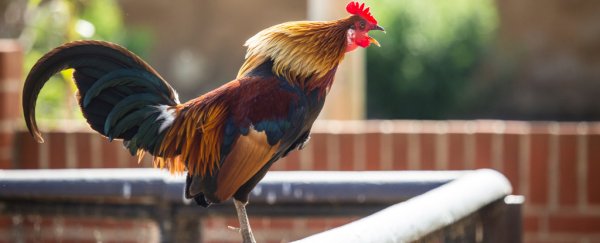A new case study describes an unusual accident: a 76-year-old woman has bled to death after a rooster pecked at her leg. The tragic death has prompted doctors to draw attention to an extremely common blood vessel condition that often comes with age.
The attack took place on a rural property in South Australia, as the older woman was collecting eggs from her chicken coop. A few aggressive pecks from the resident rooster was all it took for her to haemorrhage and collapse.
The autopsy later revealed two puncture wounds in her lower left leg, one of which was right over a varicose vein. These are weakened or damaged blood vessels with valves that do not work properly, so the blood struggles to flow effectively back to the heart.
According to the case study, when the woman realised she was bleeding, she tried to get her husband's attention. Leaving a trail of blood back to the house, she collapsed on the driveway and died before help arrived.
The deceased woman was reportedly overweight, with a medical history of high blood pressure and diabetes. Her varicose veins had been operated on in the past, but the condition was severe enough that she had trouble walking.
"There are a couple of messages, one is never trust a rooster … the second one is if you've got varicose veins, get something done about it," pathologist Roger Byard told the Australian Broadcasting Corporation.
Varicose ruptures are a chronic clinical condition that is usually benign. Severe cases, however, can lead to serious repercussions if left untreated. When a varicose vein is ruptured, it can trigger arterial bleeding and a serious medical emergency, which can be fatal.
Death from haemorrhage due to a varicose rupture is uncommon; one study found just 66 cases described in reports between 1973 and 2012. But there are characteristics which make some people more susceptible, including old age, social isolation, and underlying medical conditions, like liver cirrhosis or ischemic heart disease.
Smaller varicose veins usually aren't an issue, but if the condition is more severe, there are multiple treatment options, some of which are less invasive than others.
"The fragility of the skin and underlying soft tissues in older individuals means that varicose veins are vulnerable to injury from relatively minor trauma," pathologists explain in the clinical study.
"This has, on occasion, resulted in significant haemorrhage."
The authors also describe a similar example, communicated to them by a fellow doctor, where a house cat scratched a person's lower leg, causing an uncontrollable and ultimately fatal bleed.
The rooster, in this case, pierced an equally unfortunate spot.
"This case demonstrates that even relatively small domestic animals may be able to inflict lethal injuries in individuals if there are specific vascular vulnerabilities present," the case study reads. Something to keep in mind.
The findings were published in Forensic Science, Medicine and Pathology.
